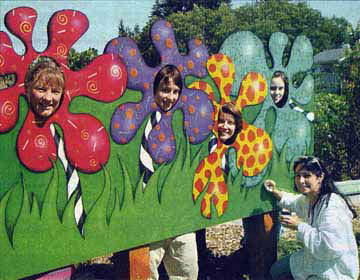The art of dressing up a pig farm

Artists (L to R) Christina Braxton, Mary Lee Nagy, Mary Anne Nagy, Tawnie Anslow, and Jules Anslow (signing her painting) created free-standing art and imaginative murals on outbuildings at Pigs Peace Sanctuary in the Cedarhome area of Stanwood the past two weekends. August 5, 2005 Duke had a passion for watching golf, and occasionally tennis, on a $3 TV set his owner purchased for him at a garage sale. Shortly before the pet pig died last spring, he was riveted to TV coverage of Pope John Paul's death and funeral, totally losing interest during commercials, chuckled Peggy Wasman, one of the many artists who volunteered their time and art to beautify Pigs Peace Sanctuary in the Cedarhome area of Stanwood. "And I never even watched golf!" said Wasman, from her perch, painting a whimsical garden on one of the many outbuildings of the pig rescue facility's 34 peaceful acres. During the last two weekends of July, artists camped out with the common goal of painting colorful murals on the sides of barns, sheds, and pens to entertain the sanctuary's resident pigs and their guests. In a spring newsletter, Judy Woods, the founder and caretaker of Pigs Peace Sanctuary, put out the invitation to all artists to camp, create and eat plentiful dishes of vegetarian delicacies during the process. 
Artwork at the farm includes a friendly reminder advertised on a sign. They arrived in droves. It's now an outside public gallery, Woods said with satisfaction following the event. Woods, formerly of Arlington, fell in love with an abused potbelly pig about 11 years ago when it was found walking the streets of Seattle. She hasn't looked back since. Mitzi, a 2-year-old pig, spends her days lying on a soft bed of straw - forced to eat and drink lying down, the victim of medical research. Norton is a loner, found locked in a dark basement ever since its owners had a baby. Ruby is crippled. Rex has neurological problems, and Molly has special needs of her own. "They are sweet, sweet pigs." said Woods. Overall, the haven has 182 pigs, a couple of wild turnkeys that flew in and stayed, a shed full of feral cats, four dogs, three ponies and a horse -all neutered or spayed. "Here, I can promise they'll never get abused again." she said. Woods nurses humans during the nightshift at Monroe Valley General Hospital, and like her patients, each of her pigs has a name and a story. "I give each one a name," said Woods. "I only take the un-adoptable ones." Woods begins ringing the chow bell while tossing out feed, and pigs come running with what looks like smiles on their faces, butting each other out of the way with a squeal to get their share. "Pigs are like kids at Disneyland when they come here." chuckled Woods. Having a potbelly pig as a pet became popular in the 1980s; however, many owners found their little hoofed pets were not solitary animals. Pigs have an instinct to establish a hierarchy. If they can't do it with other pig, they do it with people, said Woods. "Aggression is a problem with pigs." she said. "I heard people say their pig would either sleep, eat or attack." Dog shelters don't accept surrendered pigs because they are classified as farm animals, so former pig owners sometimes resort to setting their piglets free to care for themselves or opt for other cruel methods. Merlin the pig escaped to the streets of Seattle before he became the family's main entrŽe. "He escaped because he was going to be barbecued," explained Woods. "They're incredibly intelligent animals. Pigs are a third removed from humans." Potbelly pigs are dwarf swines, developed in Vietnam in the 1960s. They were first imported from Canada to the U.S. in the 1980s and were thought to be the perfect pet. The piglets began selling for as much as $5,000 each, and the breeding business exploded. "It got to be a big, profitable business." explained Woods. As a result, the market got saturated and as pigs' temperament became known, so did their popularity. Pigs are not only given as pen, food and love at Pigs Peace Sanctuary, they have the option of camping out among the farm's 17 acres of woods or under a fresh bale of straw in the barn. Pigs are known to form groups of two or three, just like people, and each has a personality of its own. "Some are the hikers, and some are the couch potatoes." she said. Woods attempts to match a pig's personality with an adoptive owner's lifestyle while encouraging them to adopt at least two. If the pigs will be living on acreage, she suggests they take the hikers, while the lazier pigs are content living in homes on small lots. Human mothers may be mystified to realize that pigs are one of the cleanest animals on earth; despite the fact mothers have compared their child's messy bedrooms to a pigpen for generations. Pigs defecate in the same place, far from their social and sleep areas, but have no natural cooling systems, so are forced to roll in mud for sun protection during summer months. "They don't like being dirty if they don't have to." explained Woods. The haven is supported by donations and is open to the public every Sunday afternoon from noon until 5 p.m. to view the art and visit the pigs. Volunteers are extremely important to the continued success and management of the facility, said Woods. Classroom teachers are welcome to make an appointment to visit the sanctuary with their students. "I always wanted to be a vet or a teacher." said Woods. "I'm doing both, just in a different way. I absolutely love this." Report Kelly Ruhoff: 360-629-8066 (ext. 106) |